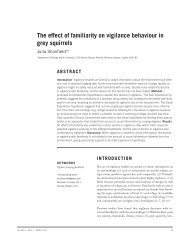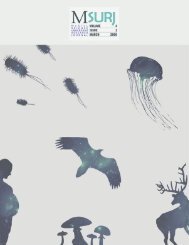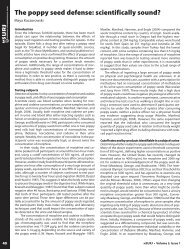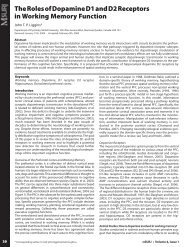the entire issue - McGill Science Undergraduate Research Journal ...
the entire issue - McGill Science Undergraduate Research Journal ...
the entire issue - McGill Science Undergraduate Research Journal ...
Create successful ePaper yourself
Turn your PDF publications into a flip-book with our unique Google optimized e-Paper software.
The effect of Eurosta solidaginis parasitism on pollinator preference in Solidago canadensis<br />
type of ramet (infected versus uninfected) that <strong>the</strong>y were visiting.<br />
Each ramet was only screened once per round for <strong>the</strong> presence of<br />
pollinators. Therefore, if a pollinator moved from one ramet to ano<strong>the</strong>r,<br />
<strong>the</strong> pollinator was counted again if it landed on a ramet that<br />
had not yet been screened. To avoid <strong>the</strong> bias of time of day, <strong>the</strong> time<br />
of trials were staggered throughout <strong>the</strong> day for a given patch. The<br />
time when each trial was performed was recorded.<br />
Statistical Methods<br />
Patch-level Pollinator Preference<br />
The hypo<strong>the</strong>sis that if patches have higher levels of infection (percentage<br />
of ramets infected by E.solidaginis) <strong>the</strong>n <strong>the</strong>y will receive less<br />
pollinator visitations was evaluated using linear mixed-effects models<br />
with nested random factors. The process of building a model that<br />
best explained <strong>the</strong> variation in <strong>the</strong> response variable and <strong>the</strong> number<br />
of visitations by pollinators involved systematically establishing <strong>the</strong><br />
best random structure and <strong>the</strong> significant fixed effects by comparing<br />
models using ANOVA. When models were not significantly different<br />
<strong>the</strong> most parsimonious model was chosen. The model was created<br />
using R statistical software and <strong>the</strong> package nlme (8). The percentage<br />
of infected ramets within a patch was arcsine transformed because<br />
non-normality is assumed for ratios. A graphical representation of<br />
<strong>the</strong> model was created using gamm4 in R statistical software (9).<br />
Ramet-level Pollinator Preference<br />
The hypo<strong>the</strong>sis that pollinators would preferentially visit uninfected<br />
ramets over infected ramets was tested by taking <strong>the</strong> difference between<br />
<strong>the</strong> proportion of total visitations per patch to infected plants<br />
and <strong>the</strong> proportion of infected ramets in <strong>the</strong> patch. This difference<br />
was arcsine transformed because non-normality is assumed for ratios.<br />
A one sample t-test was <strong>the</strong>n conducted to see if <strong>the</strong> mean difference<br />
across patches differed significantly from <strong>the</strong> null expectation<br />
of zero.<br />
Flower Counts of Infected versus Uninfected Ramets<br />
To test whe<strong>the</strong>r <strong>the</strong> proportion of open flowers in infected ramets<br />
differed significantly from <strong>the</strong> proportion of open flowers in uninfected<br />
ramets a two sample paired t-test was conducted. The proportion<br />
of open flowers was arcsine transformed because non-normality<br />
is assumed for ratios.<br />
Results<br />
Patch-level Pollinator Preference<br />
In <strong>the</strong> 23 patches, <strong>the</strong> percentage of ramets infected by E. solidaginis<br />
ranged from 0% to 61.3%. The two models with <strong>the</strong> lowest Akaike<br />
information criterion (AIC) were determined after systematically<br />
isolating <strong>the</strong> linear mixed-effects model with nested random factors<br />
that best predict <strong>the</strong> response variable-number of visitations by all<br />
pollinators to a patch. The AIC is a measure of how well <strong>the</strong> model fits<br />
<strong>the</strong> data. Both models have trials nested within patch as random factors,<br />
but differ in <strong>the</strong>ir fixed effects. The fixed effects of model 1 are<br />
<strong>the</strong> percentage of infected ramets per patch (arcsine transformed),<br />
bloom stage median of <strong>the</strong> patch and time of day when <strong>the</strong> patch was<br />
visited (Table 2).<br />
Random<br />
Effects<br />
Standard Deviation<br />
Intercept<br />
Patch 4.096<br />
Trial 2.183<br />
Fixed Effects<br />
% of Infected<br />
Ramets<br />
(arcsine<br />
transformed)<br />
Bloom Stage<br />
Median<br />
Value<br />
Residual<br />
Standard<br />
Error<br />
AIC 1327.44<br />
Degrees<br />
of<br />
Freedom<br />
t-value<br />
p-value<br />
-1.212 5.454 20 -0.2223 0.8263<br />
-2.759 1.071 20 -2.575 0.0181<br />
Time (min) 0.008692 0.002258 66 3.850 0.0003<br />
Random<br />
Effects<br />
Standard Deviation<br />
Intercept<br />
Patch 3.993<br />
Trial 2.183<br />
Fixed Effects<br />
Bloom Stage<br />
Median<br />
Value<br />
Residual<br />
Standard<br />
Error<br />
AIC 1327.44<br />
Degrees<br />
of<br />
Freedom<br />
t-value<br />
p-value<br />
-2.755 1.047 21 -2.632 0.0156<br />
Time (min) 0.008672 0.002258 66 3.842 0.0003<br />
Table 2:<br />
Model 1: a linear mixed-effects model with nested random structure.<br />
This model was not <strong>the</strong> best fit because it is not statistically<br />
different from model 2 (ANOVA: Log likelihood ratio = 0.0566144 ,<br />
p-value = 0.8119) which is <strong>the</strong> most parsimonious explanation for<br />
<strong>the</strong> variation in pollinator visitations between patches.<br />
Table 3:<br />
Model 2: a linear mixed-effects model with nested random structure.<br />
This model is <strong>the</strong> best fit for <strong>the</strong> data providing <strong>the</strong> most<br />
parsimonious explanation for <strong>the</strong> variation in pollinator visitations<br />
between patches.<br />
26<br />
<strong>McGill</strong> <strong>Science</strong> <strong>Undergraduate</strong> <strong>Research</strong> <strong>Journal</strong> - msurj.mcgill.ca









